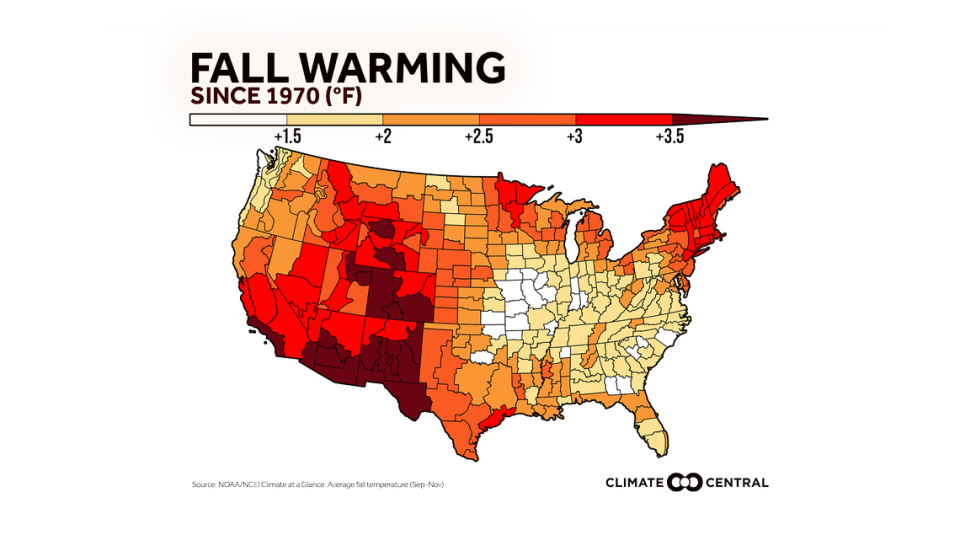How does Kansas City fare as climate change leads to warmer fall season across the U.S.?
Getting ready for sweater weather and the crispness of fall? You might have to hold off a bit longer.
Climate change is leading to a warmer fall across the United States including the Kansas City area, according to a new analysis by an independent climate change research organization.
About 95% of the 246 cities analyzed by Climate Central have seen their autumn season warm since 1970, with about 57% of those cities seeing temperatures increase by at least two degrees.
That may not sound like a lot, but it’s a sign that summer is lingering longer into the fall months. Along with that comes higher energy bills as air conditioners run later into the year. Ticks and mosquitoes stick around longer. And the allergy season is extended as air pollution is worsening, according to Climate Central.
Warmer fall seasons may negatively impact such things and bird migrations, hibernation and fruit ripening. Climate change disproportionately affects the poor and people of color.

In Kansas City, the affect of climate change on the season hasn’t been as dramatic, less than a one degree increase. Still, temperatures over the past 50 years are showing that they are trending slightly warmer.
“A lot of places just aren’t warming as much, but that’s not entirely surprising,” said Sean Sublette, a meteorologist with Climate Central.
Other cities in the region are seeing more notable increases. St. Louis, for example, saw its average fall temperature increase by 2.9 degrees, followed by Wichita at 2.8 degrees, Topeka by 2.2 degrees, Jefferson City by 2.1 degrees and Columbia by 2 degrees.
Joplin and Springfield saw their average fall temperatures increase by 1.6 and 1.5 degrees respectively.
Sublette said he couldn’t give a specific answer as to why most of Missouri, southern Iowa and western Illinois would be warming a little bit more slowly than everybody else, but he said it may be due to agricultural practices.
“Some places just warm faster than others,” he said.
For example, he said he would argue that places like the western United States, which is seeing the fall season warming more, is experiencing such because states in the region are typically drier and that leads to a net higher temperature, especially during the early fall.
The five greatest increases were seen in Reno, Nevada, by 7.6 degrees, Las Vegas by 6 degrees, El Paso, Texas, by 5.6 degrees Tucson, Arizona by 5.4 degrees and Phoenix by 5.3 degrees.
The northern parts of the United States, including the Great Lakes region and New England, also have a relatively cooler climate so they are going to see the warming more, he said.
In the Climate Central analysis, the cities in the study also have seen more warm fall days — where temperatures are above normal. Of the cities analyzed, nearly two-thirds have seen at least seven more days of above-average fall temperatures compared to 1970s. Ten cities recorded an additional month of hotter than normal days.
Kansas City had 1.4 more warm fall days. That compares to 12 more days in Wichita, 11 in St. Louis, 7.2 in Topeka, 5 in Joplin, 3.4 in Columbia, 3.3 in Springfield, and 2.2 in Jefferson City.
That can be a disappointment to those who love the fall season.
“That kind of summer feel to the air will tend to last longer into September or sometimes even October than it has in the past,” Sublette said. “That first real cool surge in the air and then certainly the first frost of the year, those are going to be tending to get a little bit later on into the year.”

